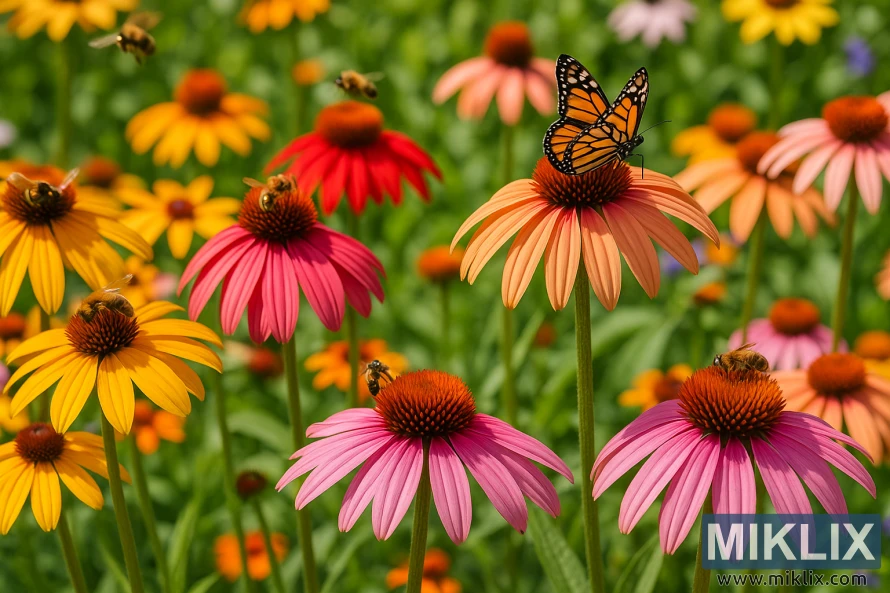Image: Pollinators at Play in a Coneflower Meadow
Published: October 24, 2025 at 10:34:21 PM UTC
A lively summer garden scene with colorful Echinacea blooms—pink, orange, red, and yellow—teeming with bees and a butterfly, highlighting coneflowers as pollinator magnets in vivid sunlight.
A sunlit burst of color fills the frame: a summer garden alive with coneflowers (Echinacea) in peak bloom and a flurry of pollinator activity. The composition centers on several tall flower stalks, each crowned by a daisy-like head—slender petals draping from raised, bristly cones. Petal colors shift joyfully from strawberry pink and watermelon magenta to warm coral, tangerine orange, and buttery yellow, with deeper crimsons glowing in the mid-ground. The cones themselves form tight, domed mosaics of florets, their russet-to-amber tones catching highlights like tiny glass beads. Veins run the length of the petals, giving a silky texture that the bright midday light turns almost translucent at the tips.
Movement animates the scene. A butterfly with orange-and-black wings—delicately edged in white—rests atop one of the taller coneflowers, wings poised as if just landed. Around it, bees patrol the patch in different phases of flight: some hovering as soft blurs, others anchored to the cones with fuzzy legs dusted in pollen. Their varied positions—one midair, another angled into the disk florets, others arcing between blooms—create a gentle rhythm that draws the eye in loops across the image. The insect traffic underscores the ecological purpose behind the beauty: each flower head is a rich buffet of nectar and pollen, an essential stop in the daily circuits of garden pollinators.
Depth of field is used to celebratory effect. Foreground blooms are rendered with crisp detail—individual florets, petal striations, and the subtle shadow beneath each cone are all legible—while the background dissolves into a soft meadow of color. Out-of-focus disks of orange and yellow imply a larger drift of coneflowers beyond the frame, amplifying the sense of abundance. The green backdrop, punctuated by hints of other summer perennials, provides cool contrast that makes the warm hues vibrate.
Light is bright but flattering, suggesting clear, dry air and a sky nearly overhead. Sunlit petal edges glow; shadows fall short and soft, lending roundness to the cones and emphasizing their geometric spirals. Where the light skims along the butterfly’s wings, the pattern becomes jewel-like; where it pools in the cone recesses, oranges deepen toward copper and mahogany. The effect is tactile—one can almost feel the warmth of the flower heads and hear the low, steady drone of foraging bees.
The planting reads as both designed and naturalistic. Stems rise at slightly varied heights, giving the bouquet a buoyant cadence. Color mingles freely—pink beside gold, red behind apricot—yet repetition of form keeps the scene coherent. It’s the quintessential midsummer moment when perennials are at full voice: sturdy, generous, resilient. Leave these cones to mature and they will feed finches later in the season; for now they feed the air with motion and the garden with purpose.
Altogether, the picture captures a living intersection of beauty and function. Vivid petals, architectural cones, and the purposeful choreography of pollinators combine into a portrait of a healthy garden ecosystem—vibrant, dynamic, and buzzing with life.
The image is related to: 12 Beautiful Coneflower Varieties to Transform Your Garden

